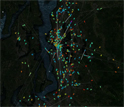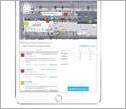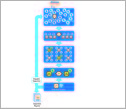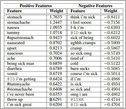News Release 16-025
Fighting food poisoning in Las Vegas with machine learning
University of Rochester-developed app helps health departments track foodborne illnesses and improves inspections

The nEmesis app collected tweets in Las Vegas and evaluated them to find cases of food poisoning.
March 7, 2016
This material is available primarily for archival purposes. Telephone numbers or other contact information may be out of date; please see current contact information at media contacts.
It's happened to many of us. We eat at a restaurant with less than ideal hygiene and come down with a nasty case of food poisoning.
Foodborne illness afflicts 48 million people annually in the U.S. alone; 120,000 individuals are hospitalized annually, and 3,000 die from the illness. In fact, one out of every six Americans gets food poisoning each year. And many of these sufferers write about it on Twitter.
Computer science researchers from the University of Rochester have developed an app for health departments that uses natural language processing and artificial intelligence to identify food poisoning-related tweets, connect them to restaurants using geotagging and identify likely hot spots.
The team presented the results of its research at the 30th Association for the Advancement of Artificial Intelligence (AAAI) conference in Phoenix, Arizona, in February. The project was supported by grants from the National Science Foundation (NSF), the National Institutes of Health and the Intel Science and Technology Center for Pervasive Computing.
Location-based epidemiology is nothing new. John Snow, credited as the world's first epidemiologist, used maps of London in 1666 to identify the source of the Cholera epidemic that was rampaging the city (a neighborhood well) and in the process discovered the connection between the disease and water sources.
However, as the researchers showed, it's now possible to deduce the source of outbreaks using publicly available social media content and deep learning algorithms trained to recognize the linguistic traits associated with a disease -- "I feel nauseous," for instance.
"We don't need to go door to door like John Snow did," says Adam Sadilek, a researcher who worked on the project at the University of Rochester and who is now at Google Research. "We can use all this data and mine it automatically."
Testing the app in Las Vegas
The work presented at AAAI described a recent collaboration with the Las Vegas health department, where officials used the app they developed, called nEmesis, to improve the city's inspection protocols.
Typically, cities (including Las Vegas) use a random system to decide which restaurants to inspect on any given day. The research team convinced Las Vegas officials to replace their random system with a list of possible sites of infection derived using their smart algorithms.
In a controlled experiment, half of the inspections were performed using the random approach and half were done using nEmesis, without the inspectors knowing that any change had occurred in the system.
"Each morning we gave the city a list of places where we knew that something was wrong so they could do an inspection of those restaurants," Sadilek said.
For three months, the system automatically scanned an average of 16,000 tweets from 3,600 users each day. 1,000 of those tweets snapped to a specific restaurant and of those, approximately 12 contained content that likely signified food poisoning. They used these tweets to generate a list of highest-priority locations for inspections.
Analyzing the results of the experiment, they found the tweet-based system led to citations for health violations in 15 percent of inspections, compared to 9 percent using the random system. Some of the inspections led to warnings; others resulted in closures.
The researchers estimate that these improvements to the efficacy of the inspections led to 9,000 fewer food poisoning incidents and 557 fewer hospitalization in Las Vegas during the course of the study.
"nEmesis has proved to be a useful tool for quickly and accurately identifying facilities in need of support, education, or regulation by the health department," says Lauren DiPrete, senior environmental health specialist for the Southern Nevada Health District.
"Adaptive inspections allow us to focus our limited resources on the restaurants with problems," says Brian Labus, a visiting research assistant professor at the University of Nevada Las Vegas's School of Community Health Sciences. "The sooner we find out about a problem, the sooner we can intervene and keep people from getting sick."
The research received an Innovative Applications of Artificial Intelligence award at AAAI as one of the best deployed applications of AI with measurable benefits.
"Adaptive inspections are significantly more effective and can make a real dent in the statistics," Sadilek said. "This case shows how you can use public data to improve public health."
Not only that, the approach can be applied to a range of other public health problems.
"This happens to be restaurants, but the method can also be used for bedbugs," he says. "Similarly, you can look what people tweet about after they visit their doctor or hospital. We're just beginning to scratch the surface of what's possible."
nEmesis serves as an example of how researchers can leverage social media users as a kind of distributed sensor network, where each person observes and reports on some aspect of the world, according to Henry Kautz, director of the Institute for Data Science at the University of Rochester and the principal investigator on the NSF-funded project that developed the app.
"Each report is very noisy, but the aggregate results can be reliable," Kautz says. "The approach can be used for health, environmental protection, public safety and many other applications."
-NSF-
-
View Video
An animation shows the ability to interpolate an individual's movement over time using social media.
Credit and Larger Version -
nEmesis web interface helps health departments identify self-reported illnesses.
Credit and Larger Version -
Adaptive inspection process used by the nEmesis app.
Credit and Larger Version -
Original map made by John Snow in 1854. Cholera cases are highlighted in black.
Credit and Larger Version -
Top 20 most significant negatively and positively weighted features in the nEmesis language model.
Credit and Larger Version
Media Contacts
Aaron Dubrow, NSF, 703-292-4489, email: adubrow@nsf.gov
Principal Investigators
Henry Kautz, University of Rochester, 585-520-1200, email: kautz@cs.rochester.edu
The U.S. National Science Foundation propels the nation forward by advancing fundamental research in all fields of science and engineering. NSF supports research and people by providing facilities, instruments and funding to support their ingenuity and sustain the U.S. as a global leader in research and innovation. With a fiscal year 2023 budget of $9.5 billion, NSF funds reach all 50 states through grants to nearly 2,000 colleges, universities and institutions. Each year, NSF receives more than 40,000 competitive proposals and makes about 11,000 new awards. Those awards include support for cooperative research with industry, Arctic and Antarctic research and operations, and U.S. participation in international scientific efforts.
Connect with us online
NSF website: nsf.gov
NSF News: nsf.gov/news
For News Media: nsf.gov/news/newsroom
Statistics: nsf.gov/statistics/
Awards database: nsf.gov/awardsearch/
Follow us on social
Twitter: twitter.com/NSF
Facebook: facebook.com/US.NSF
Instagram: instagram.com/nsfgov







